浅谈中医英语中多义词的翻译
中医词语对应的英文翻译
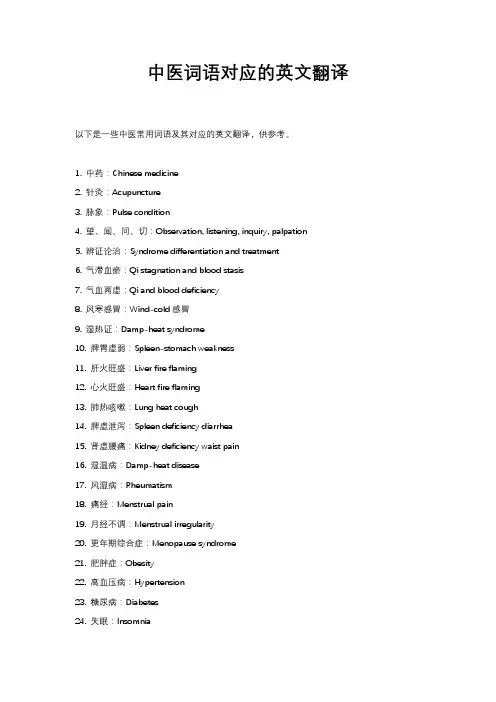
中医词语对应的英文翻译以下是一些中医常用词语及其对应的英文翻译,供参考。
1. 中药:Chinese medicine2. 针灸:Acupuncture3. 脉象:Pulse condition4. 望、闻、问、切:Observation, listening, inquiry, palpation5. 辨证论治:Syndrome differentiation and treatment6. 气滞血瘀:Qi stagnation and blood stasis7. 气血两虚:Qi and blood deficiency8. 风寒感冒:Wind-cold感冒9. 湿热证:Damp-heat syndrome10. 脾胃虚弱:Spleen-stomach weakness11. 肝火旺盛:Liver fire flaming12. 心火旺盛:Heart fire flaming13. 肺热咳嗽:Lung heat cough14. 脾虚泄泻:Spleen deficiency diarrhea15. 肾虚腰痛:Kidney deficiency waist pain16. 湿温病:Damp-heat disease17. 风湿病:Rheumatism18. 痛经:Menstrual pain19. 月经不调:Menstrual irregularity20. 更年期综合症:Menopause syndrome21. 肥胖症:Obesity22. 高血压病:Hypertension23. 糖尿病:Diabetes24. 失眠:Insomnia25. 抑郁症:Depression26. 焦虑症:Anxiety disorder27. 自闭症:Autism28. 强迫症:OCD (Obsessive-Compulsive Disorder)29. 多动症:ADHD (Attention Deficit Hyperactivity Disorder)30. 老年痴呆症:Alzheimer's disease31. 帕金森病:Parkinson's disease32. 癌症:Cancer33. 白血病:Leukemia34. 心脏病:Heart disease35. 肝病:Liver disease36. 肾病:Kidney disease37. 肺病:Lung disease38. 高脂血症:Hyperlipidemia39. 甲亢:Hyperthyroidism40. 甲减:Hypothyroidism41. 黄褐斑:Chloasma42. 白癜风:Vitiligo43. 牛皮癣:Psoriasis44. 带状疱疹:Shingles45. 水痘:Chickenpox46. 麻疹:Measles47. 风疹:Rubella (German measles)48. 痄腮:Mumps (耳下腺炎)49. 红眼病(急性结膜炎):Red eye (acute conjunctivitis)50. 中耳炎:Otitis media (middle ear infection)请注意,这些翻译可能并不完全准确或具体,因为中医是一个非常复杂和深奥的医学系统,其概念和术语往往难以用简单的英文词汇来表达,仅供参考。
中医术语名词英文翻译--3
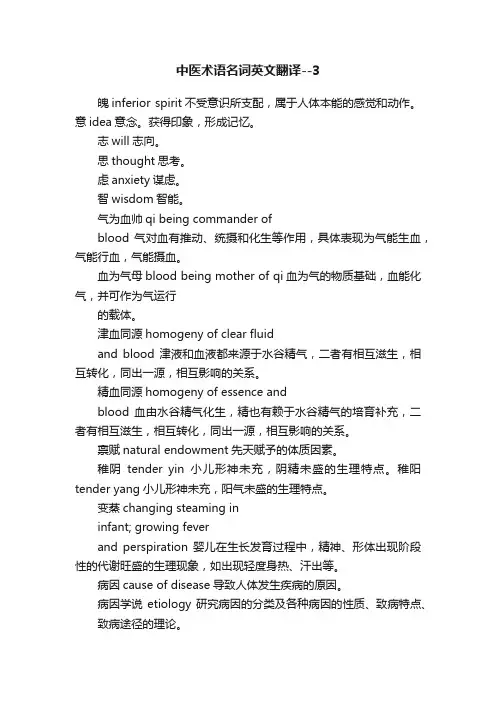
中医术语名词英文翻译--3魄inferior spirit不受意识所支配,属于人体本能的感觉和动作。
意idea意念。
获得印象,形成记忆。
志will志向。
思thought思考。
虑anxiety谋虑。
智wisdom智能。
气为血帅qi being commander ofblood 气对血有推动、统摄和化生等作用,具体表现为气能生血,气能行血,气能摄血。
血为气母blood being mother of qi血为气的物质基础,血能化气,并可作为气运行的载体。
津血同源homogeny of clear fluidand blood 津液和血液都来源于水谷精气,二者有相互滋生,相互转化,同出一源,相互影响的关系。
精血同源homogeny of essence andblood 血由水谷精气化生,精也有赖于水谷精气的培育补充,二者有相互滋生,相互转化,同出一源,相互影响的关系。
禀赋natural endowment先天赋予的体质因素。
稚阴tender yin小儿形神未充,阴精未盛的生理特点。
稚阳tender yang小儿形神未充,阳气未盛的生理特点。
变蒸changing steaming ininfant; growing feverand perspiration 婴儿在生长发育过程中,精神、形体出现阶段性的代谢旺盛的生理现象,如出现轻度身热、汗出等。
病因cause of disease导致人体发生疾病的原因。
病因学说etiology研究病因的分类及各种病因的性质、致病特点、致病途径的理论。
病起过用overuse causing disease中医病因学的基本观点。
认为四季六气与饮食营养本是人赖以生存的必备条件,七情本是人对生存环境的精神活动,劳逸作息本是人类生存和繁衍的行为方式,但是如果气候反常、饮食失调及人的各种活动过极,就成为导致疾病的根本原因。
三因three types of diseasecauses 内因、外因、不内外因的合称。
中医术语中英文版
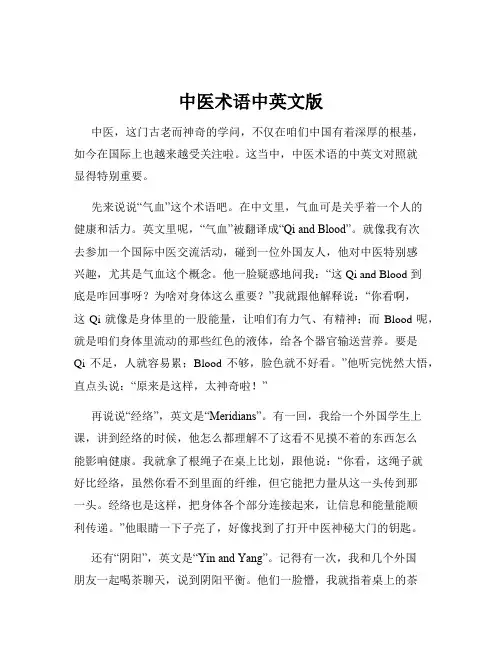
中医术语中英文版中医,这门古老而神奇的学问,不仅在咱们中国有着深厚的根基,如今在国际上也越来越受关注啦。
这当中,中医术语的中英文对照就显得特别重要。
先来说说“气血”这个术语吧。
在中文里,气血可是关乎着一个人的健康和活力。
英文里呢,“气血”被翻译成“Qi and Blood”。
就像我有次去参加一个国际中医交流活动,碰到一位外国友人,他对中医特别感兴趣,尤其是气血这个概念。
他一脸疑惑地问我:“这 Qi and Blood 到底是咋回事呀?为啥对身体这么重要?”我就跟他解释说:“你看啊,这 Qi 就像是身体里的一股能量,让咱们有力气、有精神;而 Blood 呢,就是咱们身体里流动的那些红色的液体,给各个器官输送营养。
要是Qi 不足,人就容易累;Blood 不够,脸色就不好看。
”他听完恍然大悟,直点头说:“原来是这样,太神奇啦!”再说说“经络”,英文是“Meridians”。
有一回,我给一个外国学生上课,讲到经络的时候,他怎么都理解不了这看不见摸不着的东西怎么能影响健康。
我就拿了根绳子在桌上比划,跟他说:“你看,这绳子就好比经络,虽然你看不到里面的纤维,但它能把力量从这一头传到那一头。
经络也是这样,把身体各个部分连接起来,让信息和能量能顺利传递。
”他眼睛一下子亮了,好像找到了打开中医神秘大门的钥匙。
还有“阴阳”,英文是“Yin and Yang”。
记得有一次,我和几个外国朋友一起喝茶聊天,说到阴阳平衡。
他们一脸懵,我就指着桌上的茶杯和茶壶说:“这茶杯好比 Yin,茶壶好比 Yang。
茶壶里的水倒进茶杯,茶杯满了,这就是一种平衡。
身体里的 Yin 和 Yang 也是这样,要相互协调,人才健康。
”他们这才有点明白了阴阳的意思。
“穴位”这个术语,英文是“Acupoints”。
曾经有个外国朋友因为头疼来找我,我给他介绍穴位按摩。
我指着他头上的几个地方说:“这几个Acupoints 你按一按,能缓解头疼。
”他半信半疑地按了按,过了一会儿,惊喜地说:“哎呀,真的不疼了!”“中药”,对应的英文是“Chinese Herbal Medicine”。
中医英文术语
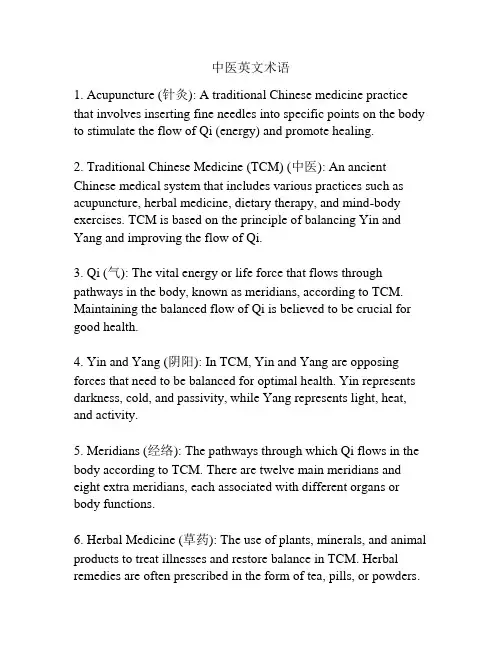
中医英文术语1. Acupuncture (针灸): A traditional Chinese medicine practice that involves inserting fine needles into specific points on the body to stimulate the flow of Qi (energy) and promote healing.2. Traditional Chinese Medicine (TCM) (中医): An ancient Chinese medical system that includes various practices such as acupuncture, herbal medicine, dietary therapy, and mind-body exercises. TCM is based on the principle of balancing Yin and Yang and improving the flow of Qi.3. Qi (气): The vital energy or life force that flows through pathways in the body, known as meridians, according to TCM. Maintaining the balanced flow of Qi is believed to be crucial for good health.4. Yin and Yang (阴阳): In TCM, Yin and Yang are opposing forces that need to be balanced for optimal health. Yin represents darkness, cold, and passivity, while Yang represents light, heat, and activity.5. Meridians (经络): The pathways through which Qi flows in the body according to TCM. There are twelve main meridians and eight extra meridians, each associated with different organs or body functions.6. Herbal Medicine (草药): The use of plants, minerals, and animal products to treat illnesses and restore balance in TCM. Herbal remedies are often prescribed in the form of tea, pills, or powders.7. Cupping (拔罐): A therapy in which glass or plastic cups are placed on the skin to create a vacuum, stimulating blood flow and relieving muscle tension. Cupping is often used for pain relief and promoting healing.8. Moxibustion (艾灸): A technique that involves burning dried mugwort herb (moxa) near the skin or on acupuncture points to warm and stimulate the flow of Qi. Moxibustion is commonly used to treat cold-related conditions.9. Tui Na (推拿): A form of Chinese therapeutic massage that involves various techniques such as kneading, pressing, and stretching to stimulate the flow of Qi and relieve pain or tension.10. Gua Sha (刮痧): A technique in which a blunt instrument, such as a special spoon or coin, is used to scrape the skin in order to promote blood circulation and alleviate pain or inflammation.11. Five Elements (五行): The concept in TCM that categorizes phenomena into five elements - Wood, Fire, Earth, Metal, and Water. Each element corresponds to certain organs, emotional characteristics, seasons, and other aspects of health.12. Pattern Differentiation (辨证论治): The TCM diagnostic method that involves analyzing a patient's symptoms and signs to determine the underlying pattern of disharmony in the body. Treatment is then tailored based on the specific pattern identified.13. Herbal Formulas (方剂): Specific combinations of herbs prescribed by TCM practitioners to address the individual pattern of disharmony. These formulas are often customized for each patient's unique needs.14. Dampness (湿): An imbalance in TCM characterized by excessive moisture or fluid accumulation in the body, which can cause symptoms such as bloating, fatigue, and heavy sensation.15. Heat (热): An excess of Yang energy in the body, leading to symptoms such as fever, thirst, inflammation, and restlessness. Heat can be caused by external factors or internal imbalances.。
中医标准化名词英语词典
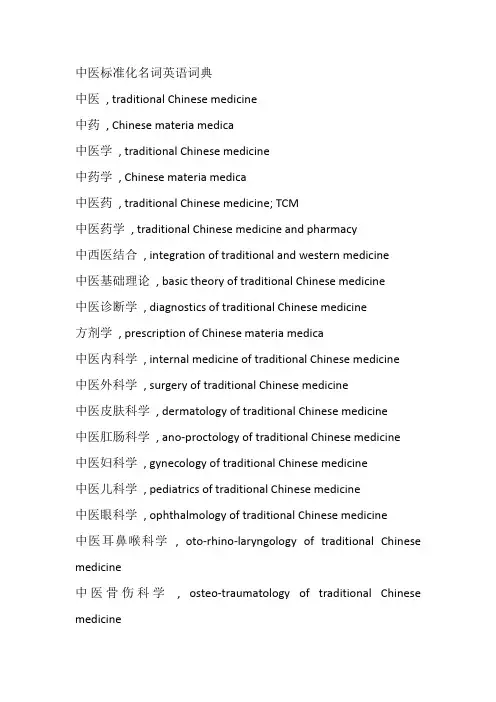
中医标准化名词英语词典中医, traditional Chinese medicine中药, Chinese materia medica中医学, traditional Chinese medicine中药学, Chinese materia medica中医药, traditional Chinese medicine; TCM中医药学, traditional Chinese medicine and pharmacy中西医结合, integration of traditional and western medicine中医基础理论, basic theory of traditional Chinese medicine中医诊断学, diagnostics of traditional Chinese medicine方剂学, prescription of Chinese materia medica中医内科学, internal medicine of traditional Chinese medicine中医外科学, surgery of traditional Chinese medicine中医皮肤科学, dermatology of traditional Chinese medicine中医肛肠科学, ano-proctology of traditional Chinese medicine中医妇科学, gynecology of traditional Chinese medicine中医儿科学, pediatrics of traditional Chinese medicine中医眼科学, ophthalmology of traditional Chinese medicine中医耳鼻喉科学, oto-rhino-laryngology of traditional Chinese medicine中医骨伤科学, osteo-traumatology of traditional Chinese medicine中医急诊学, the art of first aid of traditional Chinese medicine针灸学, the art of acu-moxibustion of traditional Chinese medicine 中医推拿学, the art of tuina of traditional Chinese medicine中医养生学, the art of healthcare of traditional Chinese medicine 中医康复学, the art of rehabilitation of traditional Chinese medicine中医护理学, the art of nursery of traditional Chinese medicine温病学, the art of warm disease of traditional Chinese medicine药用植物学, pharmaceutical botany中药化学, chemistry of Chinese materia medica中药药理学, pharmacology of Chinese materia medica中药鉴别学, identification of Chinese materia medica中药炮制学, the art of processing of Chinese materia medica中药药剂学, pharmacy of Chinese materia medica中药制剂分析, analysis of drug form of Chinese materia medica中国医学史, Chinese medical history中医文献学, Chinese medical literature中医各家学说, theory of schools of traditional Chinese medicine 医案, case histories国家中医药管理局, State Administration of Traditional Chinese Medicine中华中医药学会, China Association of Traditional ChineseMedicine and Pharmacy世界针灸学会联合会, The World Federation of Acupuncture-Moxibustion Societies中国针灸学会, China Association of Acupuncture and Moxibustion 中国中西医结合学会, Chinese Association of the Integration of Traditional and Western Medicine中国民族医药学会, Chinese Association of Minority Medicine中医师, traditional Chinese physician中药师, traditional Chinese pharmacist汉文名, 英文名五十二病方, Wushier Bing Fang; Prescriptions for Fifty-two Diseases灵枢经, Lingshu Jing; Miraculous Pivot素问, Suwen; Plain Questions黄帝内经, Huangdi Nei Jing; Inner Canon of Huangdi神农本草经, Shennong Bencao Jing; Shennong's Classic of Materia Medica难经, Nan Jing; Classic of Questioning伤寒论, Shanghan Lun; Treatise on Cold Pathogenic Diseases金匮要略, Jingui Yao Lüe; Synopsis of Golden Chamber针灸甲乙经, Zhenjiu Jia Yi Jing; A-B Classic of Acu-moxibustion脉经, Mai Jing; Pulse Classic肘后备急方, Zhouhou Beiji Fang; Handbook of Prescriptions for Emergency刘涓子鬼遗方, Liu Juanzi Gui Yi Fang; Liu Juanzi's Remedies Bequeathed by Ghosts雷公炮炙论, Leigong Paozhi Lun; Master Lei's Discourse on Drug Processing神农本草经集注, Shennong Bencao Jing Jizhu; Variorum of Shennong's Classic of Materia Medica黄帝内经太素, Huangdi Nei Jing Tai Su; Grand Simplicity of Inner Canon of Huangdi诸病源候论, Zhu Bing Yuan Hou Lun; General Treatise on Causes and Manifestations of All Diseases备急千金要方, Beiji Qianjin Yao Fang; Essential Recipes for Emergent Use Worth A Thousand Gold新修本草, Xin Xiu Bencao; Newly Revised Materia Medica千金翼方, Qianjin Yi Fang; A Supplement to Recipes Worth A Thousand Gold本草拾遗, Bencao Shiyi; A Supplement to Materia Medica食疗本草, Shiliao Bencao; Materia Medica for Dietotherapy外台秘要, Waitai Miyao; Arcane Essentials from the Imperial Library食医心鉴, Shi Yi Xin Jian; Heart Mirror of Dietotherapy海药本草, Haiyao Bencao; Oversea Materia Medica太平圣惠方, Taiping Sheng Hui Fang; Taiping Holy Prescriptions for Universal Relief经史证类备急本草, Jing Shi Zheng Lei Beiji Bencao; Classified Materia Medica from Historical Classics for Emergency太平惠民和剂局方, Taiping Huimin Hejiju Fang; Prescriptions of the Bureau of Taiping People’s Welfare Pharmacy圣济总录, Shengji Zong Lu; General Records of Holy Universal Relief本草衍义, Bencao Yanyi; Augmented Materia Medica圣济经, Sheng Ji Jing; Classic of Holy Benevolence小儿药证直诀, Xiaoer Yao Zheng Zhi Jue; Key to Therapeutics of Children's Diseases伤寒明理论, Shanghan Mingli Lun; Concise Exposition on Cold Pathogenic Diseases幼幼新书, Youyou Xin Shu; New Book of Pediatrics宣明论方, Xuan Ming Lun Fang; Clear Synopsis on Recipes三因极一病证方论, Sanyin Ji Yi Bingzheng Fang Lun; Treatise on Three Categories of Pathogenic Factors儒门事亲, Rumen Shi Qin; Confucians' Duties for Parents妇人大全良方, Furen Da Quan Liang Fang; Complete Effective Prescriptions for Women's Diseases重修政和经史证类备急本草, Chong Xiu Zhenghe Jing Shi Zheng Lei Beiji Bencao; Revised Zhenghe Materia Medica for Emergency from Classics and History Documents脾胃论, Piwei Lun; Treatise on Spleen and Stomach仁斋直指方, Renzhai Zhi Zhi Fang; Effective Recipes from Renzhai House。
中医药名词英文翻译01(学科相关词汇)
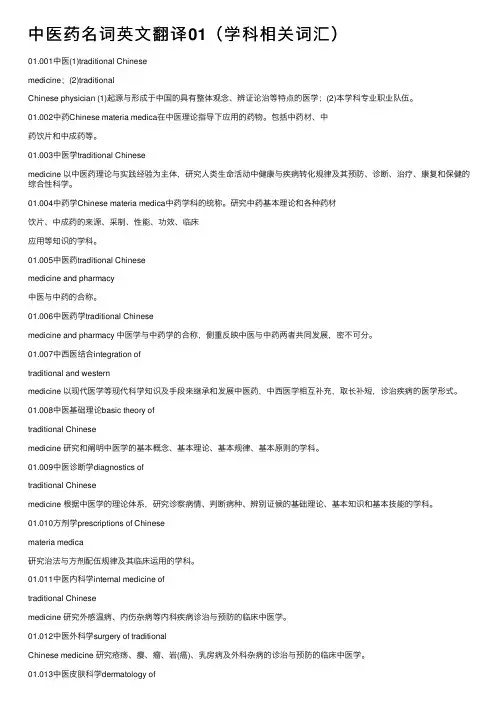
中医药名词英⽂翻译01(学科相关词汇)01.001中医(1)traditional Chinesemedicine;(2)traditionalChinese physician (1)起源与形成于中国的具有整体观念、辨证论治等特点的医学;(2)本学科专业职业队伍。
01.002中药Chinese materia medica在中医理论指导下应⽤的药物。
包括中药材、中药饮⽚和中成药等。
01.003中医学traditional Chinesemedicine 以中医药理论与实践经验为主体,研究⼈类⽣命活动中健康与疾病转化规律及其预防、诊断、治疗、康复和保健的综合性科学。
01.004中药学Chinese materia medica中药学科的统称。
研究中药基本理论和各种药材饮⽚、中成药的来源、采制、性能、功效、临床应⽤等知识的学科。
01.005中医药traditional Chinesemedicine and pharmacy中医与中药的合称。
01.006中医药学traditional Chinesemedicine and pharmacy 中医学与中药学的合称,侧重反映中医与中药两者共同发展,密不可分。
01.007中西医结合integration oftraditional and westernmedicine 以现代医学等现代科学知识及⼿段来继承和发展中医药,中西医学相互补充,取长补短,诊治疾病的医学形式。
01.008中医基础理论basic theory oftraditional Chinesemedicine 研究和阐明中医学的基本概念、基本理论、基本规律、基本原则的学科。
01.009中医诊断学diagnostics oftraditional Chinesemedicine 根据中医学的理论体系,研究诊察病情、判断病种、辨别证候的基础理论、基本知识和基本技能的学科。
01.010⽅剂学prescriptions of Chinesemateria medica研究治法与⽅剂配伍规律及其临床运⽤的学科。
中医英语词汇
中医英语词汇下面是店铺整理的中医英语词汇,以供大家学习参考。
中医①traditional Chinese medicine②traditional Chinese physician ①中医学的简称。
②本学科专业职业队伍。
中医学traditional Chinese medicine 以中医药理论与实践经验为主体,研究人类生命活动中健康与疾病转化规律及其预防、诊断、治疗、康复和保健的综合性科学。
中医药 traditional Chinese medicine and pharmacology 中医与中药的合称。
中医药学 traditional Chinese medicine and pharmacology 中医学与中药学的合称,侧重反映中医与中药两者共同发展,密不可分。
中药Chinese materia medica 在中医理论指导下应用的药物。
包括中药材、中药饮片和中成药等。
中药学Chinese materia medica 中药学科的统称。
研究中药基本理论和各种药材饮片、中成药的来源、采制、性能、功效、临床应用等知识的学科。
中西医结合 integration of traditional and western medicine 现代医学等现代科学知识及手段来继承和发展中医药,中西医学相互补充,取长补短,诊治疾病的医学形式。
中医基础理论 basic theory of traditional Chinese medicine 研究和阐明中医学的基本概念、基本理论、基本规律、基本原则的学科。
中医诊断学 diagnostics of traditional Chinese medicine 根据中医学的理论体系,研究诊察病情、判断病种、辨别证候的基础理论、基本知识和基本技能的学科。
方剂学 prescriptions of Chinese materia medica 研究治法与方剂配伍规律及其临床运用的学科。
目的论指导下医学词汇中多义词的翻译方法
目的论指导下医学词汇中多义词的翻译方法引言:在医学领域中,有很多的术语和词汇是多义词,这对翻译者来说是一项非常困难的任务。
因为多义词会给翻译带来很大的挑战,如果不加以区分,很容易引起误解和歧义。
因此,在翻译医学词汇时,必须要遵循目的论的指导,根据上下文和翻译目的选择合适的翻译方法,避免翻译中出现歧义和误解。
一、多义词的定义多义词是指一种词汇有两个或两个以上的含义,这种现象在语言中很普遍。
在医学领域中,也存在很多的多义词,如“心肌梗死”可以表达狭义的意思,即冠状动脉闭塞所导致的心肌缺血坏死,也可以表达广义的意思,即各种原因所导致的心肌缺血坏死。
二、目的论的应用目的论是语用学的一个分支,其基本思想是根据使用语言的具体目的,来选择最合适的语言形式和表达方式。
在医学翻译中,根据翻译目的和上下文的特点,选用合适的翻译方法,有助于避免翻译中的误解和歧义。
常见的翻译方法包括以下几种:1. 根据上下文的意义进行选择在医学翻译中,多义词的含义往往取决于其所处的上下文。
因此,在翻译多义词时,需要根据上下文的意义进行选择。
例如,在描述胃肠道疾病时,有时用到的“胃炎”和“肠炎”,如果上下文中没有其他限定信息,就需要根据语境进行具体的解释说明。
不同的文化习惯会影响词汇的使用,因此在翻译时,需要根据目标读者的文化背景来选择翻译方法。
例如,在西方国家,习惯将“癫痫”翻译为“epilepsy”,而在中国,习惯将其翻译为“癫痫病”。
3. 根据学科特点进行选择医学是一个细致复杂的学科,其术语和词汇的含义往往与其他学科不同。
因此,在进行医学翻译时,需要根据学科特点进行选择。
例如,在翻译心脏病时,需要根据其具体类型和临床表现进行选择。
三、常见多义词的翻译方法1. 心肌梗死常见的翻译方法包括:Myocardial infarction、heart attack、coronary heart disease。
其中,Myocardial infarction是最准确的术语,可以代表狭义的含义,heart attack则可以代表广义的含义。
中医术语名词英文翻译--4
气随液脱depletion of fluidinvolving qi desertion 大汗、大吐、大泻,使津液大量丢失,气亦随津液大量外泄而脱失的危重病理变化。
气阴两虚deficiency of both qiand yin气虚和阴虚同时并见的病理变化。
内风endogenous wind又称“肝风内动”,“虚风内动”。
指由脏腑机能失调而引起具有动摇、震颤特点之各种症状的病理变化,与肝脏关系最为密切。
包括阴虚风动、肝阳化风、血虚生风、热极生风等。
风胜则动predominate wind causingmotion 风邪侵袭,或肝风内动,出现头目肢体动摇、震颤等的病理变化。
阴虚风动stirring wind due to yindeficiency 肝肾阴液枯竭,筋脉失养而风气内动的病理变化。
肝阳化风hyperactive liver yangcausing wind 肝肾阴亏,水不涵木,肝阳亢逆无制而动风的病理变化。
热极生风extreme heat causingwind 邪热炽盛,伤及营血,燔灼肝经,筋脉失养而挛急抽搐的病理变化。
血虚生风blood deficiency causingwind血液亏虚,筋脉失养,虚风内动的病理变化。
血燥生风blood dryness causingwind 血虚津亏,失润化燥,肌肤失于濡养而致干燥瘙痒及脱屑的病理变化。
痰瘀生风phlegm stasis causingwind 痰与瘀血壅阻经络,阻碍气血,使脏腑功能失常而引动内风的病理变化。
内寒endogenous cold与外寒相对,指脾肾阳虚,不能温煦机体脏腑,而使阴寒内生的病理变化。
内湿endogenous dampness与外湿相对,指脾肾阳虚,运化失职,导致体内水液停滞而湿浊内生的病理变化。
湿胜[则]濡泻predominant dampnesscausing diarrhea湿邪偏盛就容易导致大便湿软泄泻的病理变化。
中医相关英语词汇
中医相关英语词汇中医是我们的文化遗产,在外国也是很有名的。
下面是我整理的中医相关英语词汇,仅供参照。
中国医药学Traditional Chinese Medicine治未病prevention of disease脏腑zang-organs and fu-organs, viscera中医基础理论Basic theory of traditionalChinese medicine临床经验clinical experience功能活动functional activities形神统一unity of the body and spirit辨证论治treatment based on syndromedifferentiation本草materia medica, herbs阴阳失调imbalance of yin and yang中药Chinese materia medica, Chinese条达舒畅free developmentmedicinal herbs四气五味four properties and five tastes延年益寿prolonging life, promising longevity针灸acupuncture and moxibustion, acumox养生防病cultivating health to prevent disease各家学说theories of different schools正气healthy qi, vital qi汗法diaphoresis, sweating therapy病邪pathogenic factor下法purgative therapy, purgation整体观念concept of holism3中医英语词汇有哪些生理功能physiological functions阳消阴长yang waning and yin waxing 病理变化pathological changes阴胜则阳病predominance of yin leading todisorder of yang临床诊断clinical diagnosis阴胜则阳病an excess of yin leads to deficiency of yang 阳胜生外热exuberance of yang leading to exterior heat 阳胜则热predominance of yang generatingheat阳中求阴obtaining yang from yin寒极生热extreme cold generating heat 绝对偏盛absolute predominance热极生寒extreme heat generating cold 阳虚则寒yang deficiency leading to cold阳损及阴impairment of yang involving yin 阴阳俱损simultaneous consumption of yin andyang阴液不够insufficiency of yin-fluid 阴阳两虚simultaneous deficiency of both yin andyang病机总纲general principle of pathogenesis 阳虚发热fever due to yang deficiency病机pathomechanism, pathologicalmechanism阴阳自和natural harmony between yin and yang 阴阳胜复alternative predominance of yinand yang木乘土the wood over-restrains the earth虚寒证deficiency-cold syndrome 木火刑金wood-fireimpairs the metal扶阳退阴strengthening yang to reduce yin 金水相生generation between the metal andwater祛风散寒expelling/eliminating wind to dispersing cold 生克制化interrelationship between generation and restriction 消导积滞promoting digestion and removingfood retention制则生化restriction ensuring generation。
- 1、下载文档前请自行甄别文档内容的完整性,平台不提供额外的编辑、内容补充、找答案等附加服务。
- 2、"仅部分预览"的文档,不可在线预览部分如存在完整性等问题,可反馈申请退款(可完整预览的文档不适用该条件!)。
- 3、如文档侵犯您的权益,请联系客服反馈,我们会尽快为您处理(人工客服工作时间:9:00-18:30)。
浅谈中医英语中多义词的翻译张欣悦万敏丁润刚邓兰萍成都中医药大学针灸推拿学院中医学(针灸英语方向)2010级摘要:中医被认为是中国古文明伟大文化遗产中一颗璀璨的明珠,其特色逐渐被世界认可和接受。
随着中医的国际化,其翻译中存在的问题也越来越突出。
中医理论的独特性及其在语言表达方面的特点,使中医的翻译任务艰巨而复杂,至今尚未形成统一完整的翻译理论体系,在具体的翻译上也存在着众多版本,尤其是关于多义词的翻译,其中不乏欠妥之处。
笔者就中医多义词具体的翻译原则和方法提出一些建议。
关键词:中医英语多义词翻译经过几千年的医疗实践中,中医已逐步发展为一个完整而又独特的科学体系,并且在治疗和预防疾病方面发挥重要作用。
基于中医的疗效明显、副作用小的特点,世界卫生组织把它作为一种有用的经验向全世界推荐。
中医英语翻译充当着中医走向全世界人民的桥梁,然而,由于中医历史悠久、理论独特和语言特殊等一系列的原因,这座桥梁尚未令人满意地发挥作用[1]。
在实践中,存在着中医名词术语翻译多样化、缺乏统一的翻译标准与原则等多种问题。
如将“五行”译为five elements,five phase,Wuxing等诸多版本[2]。
这些因素导致了外国学习者的重重困惑,阻碍了中医的进一步发展。
中医经典著作颇多,一字一句都需细细揣摩。
在翻译时尤其要把握好“深、浅、轻、淡”的度,不及或太过都无法准确地传达原文的思想[3]。
严复在《天演论》中提到翻译要遵循“信、达、雅”三字原则,“信”即忠实于原文,但中医中一词多义用法颇多,就此笔者结合专业特色,对中医英语多义词的翻译提出两种方法。
1 结合语境,一词多译汉语文化的博大精深,在中医中得到了很好的体现,一词多义的用法屡见不鲜。
但翻阅众多中医翻译书籍,多数译者单纯的一词一译,不能很好的结合语境,忠实原文。
就此问题,笔者将以“清”、“浊”两字为例,具体阐述结合语境翻译法。
“清”和“浊”是中医经典中常用的两个字。
如《灵枢·营卫生会篇》言:“清者为营,浊者为卫”;《素问·阴阳应象大论》言:“清阳出上窍,浊阴出下窍”。
现代翻译中多统一将“清”译作“lucid”,而“浊”译为“turbid”。
《第六版牛津高阶英汉双解词典》[4](以下简称牛津词典)中对"lucid"的解释为:○1clearly expressed; easy to understand 表达清楚的,易懂的;○2able to think clearly, especially during or after a period of illness or confusion (尤指生病期间或病愈后,糊涂状态中或过后)头脑清晰的,清醒的。
对于“turbid”的释义为"full of mud, dirt, etc, so that you can not see through it "浑浊的,污浊不清的。
实际上清和浊的含义远非lucid和turbid能够概述。
就“清阳出上窍,浊阴出下窍”而言。
《内经选读》[5]对其的解释是:水谷之精气上奉于头面五官,饮食化生之后的糟粕经下窍二阴排除体外。
即此处的“清阳”指水谷之精气,《素问·经脉别论篇》 :“饮入于胃 ,游溢精气 ,上输于脾。
脾气散精 ,上归于肺 ,通调入道 ,下输膀胱。
水精四布 ,五经并行 ,合于四时五脏阴阳 ,揆度以为常也。
”即是说 ,饮食进入人体胃腑后 ,通过胃的腐熟 ,脾的运化,水谷精微转化成人体所需要的气、血、津液等 ,通过五脏六腑输布全身,维持人体生命不息[6]。
所以此处“清阳”翻译为"the essence of food and wanter"比单纯解释为“lucid”更为妥帖。
“浊阴”指二便等经人体消化后的糟粕之物,牛津字典对turbid的解释“浑浊的,污浊不清的”含义用在此处较为妥帖,所以直接翻译为"the turbid yin"即可表达此意。
但“清者为营,浊者为卫”的含义有所不同。
营气,是由脾胃化生的水谷精微中最精专柔和、最富有营养的部分所生,《素问·痹论》说:“荣者,水谷之精气也。
”营气具有化生血液、营运血液、营养全身的作用,与卫气相对而言,属于阴,故又有“营阴”之称。
卫气,是由脾胃化生的水谷精微中最剽疾滑利的部分所生。
《素问·痹论》说:“卫者,水谷之悍气也。
”卫气行于脉外,具有“温分肉,充皮肤,肥腠理,司开合”(引自《灵枢·本藏》)的作用。
与营气相对而言属阳,故又有“卫阳”之称。
现代通常翻译为“lucid part transforming into nutrient qi,turbid part transforming into defense qi”,根据上文提到的牛津字典对于lucid和turbid的释义,可知这两个单词用来翻译清浊实为不妥。
此言中,清和浊都是精微物质,所以可用“essence”诠释。
而相对的精专柔和和剽疾滑利的特点,可以用clear 和sharp来区分。
牛津词典中对于clear的释义较多,其中“清澈”之意用在此处比较合适。
而sharp既有“clear and define”之意,又有“sudden and rapid,especially of a changein sth”之意,此种表达方式既能表现卫气本是水谷精微的本质,又展现了其剽疾滑利之特性。
所以清者为营浊者为卫的中清和浊应该分别翻译为“the clear of the essence","the sharp of the essence"由此可见,翻译中医时应结合语境,理解其具体含义,根据语境,一词多义,才能翻译出中医的精髓。
2 音译法在博大精深的中医文化面前,再顶尖的翻译家有时也感到无能为力,尤其是抽象或者含义众多或者有的特定意义的词语,因为没有哪个英文词汇可以准确传达出其中的真谛。
此时可以别辟蹊径,采用音译。
2.1 音译在中医翻译中的使用现状《译学词典》[7]对音译的解释是:“音译也称转写,即用一种文字符号(如拉丁字母)来表示另一文字系统的文字符号(如汉字)的过程或结果。
”中译英中的音译,即以拼音代替英语的翻译方法。
此方法在中医英语的翻译中尤为实用,因为很多中医词汇是中国特有的文化精髓,英文中存在文化空缺,无法找出合适的单词与之相对应,勉强意译之后又无法完整的体现原来的含义。
就目前中医的翻译现状来看,音译使用频率不高,且仅有Qi,yin yang 等少数词汇的音译得到了广泛的认可。
2.3 音译的特色及未来在中医翻译中的发展前途在大部分人看来,翻译时采用拼音是一种无能的表现。
殊不知,这正是汉语文化博大精深的体现,尤其是在中医文化中。
如“阴阳”适用于天地、昼夜、男女……简单的两个字几乎囊括世间万物,这是任何一种文化都难以比肩的。
如若翻译,也只有"yin and yang" 能够不损失其中的真谛。
在文化空缺面前,我们必须承认,并且相互弥补,音译即为很好的途径。
就此,笔者以“运气”和“痹”为例,详细论述中医英语,尤其是多义词的音译方法和原则。
运气,在中医中也叫五运六气,是研究自然界天象、气象变化规律与人类疾病发生与流行关系的学说[5]。
《素问·宝命全形论》有云:“人以天地之气生,四时之法成。
”天象日月星辰的运转、春夏秋冬循环的更替、风寒暑湿燥火的变化,影响着人类的健康与生存、疾病的发生与流行。
此处,五运即木火土金水,六运指风寒暑湿燥火。
此外,在气功中亦有“运气”之说,即把全身之气灌注到身体某一部分。
五代王仁裕《开元天宝遗事·唤铁》:“太白山有隐士郭休,字退夫,有运气绝粒之术。
”清纪昀《阅微草堂笔记·滦阳续录三》:“其乡有导引求仙者,坐而运气,致手足拘挛。
”由此可见,运气也是中国功夫神奇所在。
现在,运气又常用于指机遇机会等,此种用法时,英语有对应词汇,即可译为luck在此不作详解。
而前两种含义是英语的文化空缺。
现在“五运六气”的常用翻译法有five movements and six climates; five circuit phases and six atmospheric influences;five movements and six qi;five evolutive phases and six climatic changes. 其中将“气”直译为"qi"或者"climate"尚可理解,而将“运”翻译为"movement"着实有些不可理喻,movement意为运动,与木火土金水的意思毫不相干,此种翻译将中医含义大打折扣。
此时,音译即可发挥其特色,与其片面的理解翻译,不如直接用"yun qi",五运六气即可翻译为"five yun and six qi"。
“痹"出自《黄帝内经》:“黄帝问曰:痹之安生?岐伯对曰:风寒湿三气杂至,合而为痹也。
其风气胜者为行痹,寒气胜者为痛痹,湿气胜者为著痹也。
”现代解释为:由风、寒、湿、热等引起的以肢体关节及肌肉酸痛、麻木、重着、屈伸不利,甚或关节肿大灼热等为主症的一类病证。
病因有正虚和邪侵。
而目前对于“弊”的翻译也五花八门,如”arthralgia”(关节痛)、”disadvantage”(不利)等,虽然该译法易于理解,但是却意义狭窄,不够全面。
不能代表“痹”特点:多种病因夹杂而成且与体质病性等相关。
所以此处,不妨直接采用音译的方法,即为“Bi-syndrome”,从而避免误解。
当然,音译亦不可滥用,如果英语中有对应的单词可以完整的表达含义时,尽量不要选用音译,以免增加理解上的困难。
而文章中在首次使用音译词时,最好将详细含义注释于后,以帮助理解。
初学者亦可以借助中医英语字典。
待逐步形成约定俗成的翻译法时,便可省去此步骤。
随着中国在世界上影响力的提升,汉语文化的传播也越来越广,相信中医音译法必将在中医翻译中越来越受欢迎。
小结所谓上乘之译,无非是自然流畅且符合原文之意的译文[3]。
然和对于中医来说,翻译出上乘的文章来并非易事。
丰富的中医知识和较高的英文水平都是必不可少的。
本文中提到两种方法(一词多译和音译),笔者认为对多义词的翻译较为适用,当然翻译时也要结合实际情况,灵活掌握。
秉着将中医推广到世界的共同目的,相信越来越多的人会加入到翻译队伍,统一完整的翻译理论体系也指日可待。
【参考文献】[1] 刘国伟. 中医英语翻译的标准化研究[D]. 山东师范大学, 2008.[2] 张晓明. 中医英语翻译问题探讨[J]. 亚太传统医药, 2009(5(9)).[3] 李照国, 张庆荣. 中医英语[M]. 第一版. 上海科学技术出版社, 2009.[4] Hornby A S. Oxford Advanced Learner's English-Chinese Dictionary[M]. 第七版. 牛津大学出版社, 2009[5] 张新渝. 内经选读[M]. 第一版. 中国医药科技出版社, 2012.[6] 彭中斗. “饮入于胃,游溢精气,上输于脾。
